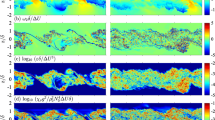Abstract
The upward transfer of heat from ocean to atmosphere is examined for an Arctic “lead”, a break in the Arctic ice which allows contact between the cold atmosphere and the relatively warm ocean. We employ a large-eddy model to compute explicitly the three-dimensional turbulent response of the atmosphere to a lead of 200 m width. The surface heat flux creates a turbulent “plume” of individual quasi-random eddies, not a continuous updraft, which penetrate into the stable atmosphere and transport heat upward.
Maximum updraft velocities and turbulence occur downwind of the lead rather than over the lead itself, because the development time of an individual thermal eddy is longer than its transit time across the lead. The affected vertical region, while shallow over the lead itself, grows to a height of 65m at 600 m downwind of the lead; beyond that, the depth of the turbulent region decreases as the eddies weaken. The maximum vertical turbulent heat flux occurs at the downwind edge of the lead, beyond which a relative maximum extends upward into the plume. Negative surface heat flux immediately downwind of the lead creates a growing stable layer, but above that internal boundary layer the turbulent heat flux is still positive. Updraft maxima are typically 28 cm/s, but compensating downdrafts result in time-averaged vertical velocities of less than 1 cm/s in the plume. Conditional sampling separates the updraft and downdraft contributions. Formulas for the horizontal eddy development distance and for the vertical plume penetration height are presented. The relative importance of mean and turbulent transport is compared for both vertical and horizontal heat transfer: turbulence dominates the vertical heat transport whereas mean advection dominates the horizontal transport, these offsetting transports producing a quasi-stationary state.
Similar content being viewed by others
References
Andreas, E. L. and Murphy, B.: 1986, ‘Bulk Transfer Coefficients for Heat and Momentum over Leads and Polynyas’,J. Phys. Oceanogr. 16, 1875–1883.
Andreas, E. L., Paulson, C. A., Williams, R. M., Lindsay, R. W. and Businger, J. A.: 1979, ‘The Turbulent Heat Flux from Arctic Leads’,Boundary-Layer Meteorol. 17, 57–91.
Businger, J. A., Wyngaard, J. C., Izumi, Y. and Bradley, E. F.: 1971, ‘Flux Profile Relationships in the Atmospheric Surface Layer’,J. Atmos. Sci. 28, 181–189.
Klemp, J. B. and Durran, D. R.: 1983, ‘An Upper Boundary Condition Permitting Internal Gravity Wave Radiation in Numerical Mesoscale Models’,Mon. Weather Rev. 111, 430–444.
Ledley, T. S.: 1988, ‘A Coupled Energy Balance Climate-Sea Ice Model: Impact of Sea Ice and Leads on Climate’,J. Geophys. Res. 93, 15919–15932.
Lo, A. K.: 1986, ‘On the Boundary-Layer Flow over a Canadian Archipelago Polynya’,Boundary-Layer Meteorol. 35, 53–71.
Maykut, G. A.: 1978, ‘Energy Exchange over Young Sea Ice in the Central Arctic’,J. Geophys. Res. 83, 3646–3658.
Moeng, C.-H.: 1984, ‘A Large-Eddy Simulation Model for the Study of Planetary Boundary-Layer Turbulence’,J. Atmos. Sci. 41, 2052–2062.
North, G. R. and Coakley, J. A.: 1979, ‘Differences between Seasonal and Mean Annual Energy Balance Model Calculations of Climate and Climate Sensitivity’,J. Atmos. Sci. 36, 1189–1204.
Schnell, R. C., Barry, R. G., Miles, M. W., Andreas, E. L., Radke, L. F., Brock, C. A., McCormick, M. P. and Moore, J. L.: 1989, ‘Lidar Detection of Leads in Arctic Sea Ice’,Nature 339, 530–532.
Shreffler, J. H.: 1975, ‘A Numerical Model for Heat Transfer to the Atmosphere from an Arctic Lead’, Ph.D. Thesis, Dept. of Oceanogr., Oregon State Univ., Corvallis, 135 pp. (Available from University Microfilms, 300 North Zeeb Road, Ann Arbor, MI 48106.)
Smith, S. D., Anderson, R. J., den Hartog, G., Topham, D. R. and Perkin, R. G.: 1983, ‘An Investigation of a Polynya in the Canadian Archipelago: 2, Structure of Turbulence and Sensible Temperature’,J. Geophys. Res. 88, 2900–2910.
Smith, S. D., Muench, R. D. and Pease, C. H.: 1990, ‘Polynyas and Leads: An Overview of Physical Processes and Environment’,J. Geophys. Res. 95, 9461–9479.
Turner, J. S.: 1973,Buoyancy Effects in Fluids, Cambridge University Press, Cambridge, 368 pp.
Untersteiner, N. (ed.): 1986,The Geophysics of Sea Ice, Plenum Press, N.Y., 1196 pp.
Washington, W. M. and Meehl, G. A.: 1984, ‘Seasonal Cycle Experiment on the Climate Sensitivity Due to a Doubling of CO2 with an Atmospheric General Circulation Model Coupled to a Simple Mixed-Layer Ocean Model’,J. Geophys. Res. 89, 9475–9503.
Wetherald, R. T. and Manabe, S.: 1981, ‘Influence of Seasonal Variation upon the Sensitivity of a Model Climate’,J. Geophys. Res. 86, 1194–1204.
Wilczak, J. M. and Businger, J. A.: 1983, ‘Thermally Indirect Motions in the Convective Atmospheric Boundary-Layer’,J. Atmos. Sci. 40, 343–358.
Author information
Authors and Affiliations
Rights and permissions
About this article
Cite this article
Glendening, J.W., Burk, S.D. Turbulent transport from an arctic lead: A large-eddy simulation. Boundary-Layer Meteorol 59, 315–339 (1992). https://doi.org/10.1007/BF02215457
Accepted:
Issue Date:
DOI: https://doi.org/10.1007/BF02215457




